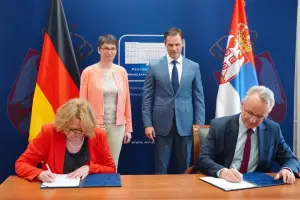- Serbia
Get to know Serbia
- Citizens
Culture and science
Health services
Pension and disability insurance
- Business
Employment
Economy
- Media
- Government
- Contact
Keep in touch
Contact form
Back
Keepin touch
Whether you have a question, comment, suggestion or any problem in the purview of the government, send us your message and we will try to respond as soon as possible. If your problem is not in our purview, we will forward your message to the relevant institution.
Q:
A:
Serbia-Montenegro leading reformer among countries in transition
Belgrade,
17 November 2005
Senior Economist of the European Bank for Reconstruction and Development (EBRD) Peter Sanfey said today that Serbia-Montenegro tops the list of 27 countries in transition as a leading reformer in the period between September 2004 and September 2005.
Presenting a report on transition in 2005, Sanfey said that the greatest progress has been achieved in the banking sector, privatisation and market liberalisation, company management and liberalisation of trade.
He said that this strong reform process surprised some in the EBRD because the situation in the country is very difficult, adding that a lot more needs to be done.
According to Sanfey, Serbia has made significant progress but according to overall progress in the transition process it is still behind the most of the countries in the region, including Romania, Bulgaria and Croatia.
Sanfey said that one of the major challenges for Serbia-Montenegro is preservation of macro economic stability, and that special attention should be paid to reducing the inflation rate.
It is necessary to attract more "greenfield" investments in new projects, Sanfey said and said that this year Serbia-Montenegro, as well as all of southeastern Europe, will have the record level of foreign direct investment (FDI). He added that the expected $1.6 million in FDI will come mostly from privatisation.
Sanfey said that economic growth of 27 countries in transition, which includes eight countries of central Europe and the Baltics, seven countries of southeastern Europe and 12 countries of the Union of Independent States, has been slowed down to 5.2 percent this year and said that that is still very good, since the economic growth in the European Union is one percent.
According to the 12th report of the EBRD on countries in transition, Serbia-Montenegro is expected to have an economic growth of at least four percent.
Payments deficit is the standard problem in transition countries, including Serbia-Montenegro, said Sanfey adding that foreign debt is a problem in both Serbia-Montenegro and Croatia, while at the same time political differences must not be disregarded.
“Solving the status issue of Kosovo-Metohija is important for attracting investments and that is not only in Serbia-Montenegro. Certain barriers for successfully doing business have arisen in the financial sector, which is perhaps hard to explain since a thorough reform of the banking system has been implemented”, he said. According to Sanfey, there is one explanation for this and that is that before the reforms took place, companies did not know how to get loans and therefore had no problems in this area.
Sanfey said that Serbia-Montenegro has achieved great success in fighting corruption and bribery, which has been confirmed by EBRD experts. According to their research, companies in the private sector usually offer larger bribes.
He said he is very optimistic regarding Serbia-Montenegro’s economic mid- and long-term development, though it is necessary to perform restructuring of large public companies, remove obstacles for doing business and conduct careful monetary and financial policies.
“Serbia-Montenegro has yet to face numerous challenges and that is a fact. This is its fifth year in the transition process and matters of crucial importance are before it”, concluded Sanfey.
He said that this strong reform process surprised some in the EBRD because the situation in the country is very difficult, adding that a lot more needs to be done.
According to Sanfey, Serbia has made significant progress but according to overall progress in the transition process it is still behind the most of the countries in the region, including Romania, Bulgaria and Croatia.
Sanfey said that one of the major challenges for Serbia-Montenegro is preservation of macro economic stability, and that special attention should be paid to reducing the inflation rate.
It is necessary to attract more "greenfield" investments in new projects, Sanfey said and said that this year Serbia-Montenegro, as well as all of southeastern Europe, will have the record level of foreign direct investment (FDI). He added that the expected $1.6 million in FDI will come mostly from privatisation.
Sanfey said that economic growth of 27 countries in transition, which includes eight countries of central Europe and the Baltics, seven countries of southeastern Europe and 12 countries of the Union of Independent States, has been slowed down to 5.2 percent this year and said that that is still very good, since the economic growth in the European Union is one percent.
According to the 12th report of the EBRD on countries in transition, Serbia-Montenegro is expected to have an economic growth of at least four percent.
Payments deficit is the standard problem in transition countries, including Serbia-Montenegro, said Sanfey adding that foreign debt is a problem in both Serbia-Montenegro and Croatia, while at the same time political differences must not be disregarded.
“Solving the status issue of Kosovo-Metohija is important for attracting investments and that is not only in Serbia-Montenegro. Certain barriers for successfully doing business have arisen in the financial sector, which is perhaps hard to explain since a thorough reform of the banking system has been implemented”, he said. According to Sanfey, there is one explanation for this and that is that before the reforms took place, companies did not know how to get loans and therefore had no problems in this area.
Sanfey said that Serbia-Montenegro has achieved great success in fighting corruption and bribery, which has been confirmed by EBRD experts. According to their research, companies in the private sector usually offer larger bribes.
He said he is very optimistic regarding Serbia-Montenegro’s economic mid- and long-term development, though it is necessary to perform restructuring of large public companies, remove obstacles for doing business and conduct careful monetary and financial policies.
“Serbia-Montenegro has yet to face numerous challenges and that is a fact. This is its fifth year in the transition process and matters of crucial importance are before it”, concluded Sanfey.
-
 Belgrade/Athens, 17 July 2025
Belgrade/Athens, 17 July 2025Serbia continues to align with EU in field of energy
-
 Kostolac, 14 July 2025
Kostolac, 14 July 2025First solar power plant Petka in Kostolac put into trial operation
-
 Belgrade, 11 July 2025
Belgrade, 11 July 2025Potential for improving cooperation with Belarus in many areas
-
 Požega, 5 July 2025
Požega, 5 July 2025Section of Pakovraće - Požega highway officially opened
-
 Belgrade, 2 July 2025
Belgrade, 2 July 2025Technical specifications defined for Serbia-Hungary oil pipeline
-
 Belgrade, 30 June 2025
Belgrade, 30 June 2025IMF confirms Serbia successfully implementing all agreed reforms
-
 Belgrade, 27 June 2025
Belgrade, 27 June 2025Double Taxation Avoidance Agreement with Germany signed
-
 Kostolac, 25 June 2025
Kostolac, 25 June 2025Construction of Kostolac wind farm nearing completion
-
 Belgrade, 24 June 2025
Belgrade, 24 June 2025Government supports request for new postponement of sanctions against NIS
-
 Belgrade, 23 June 2025
Belgrade, 23 June 2025Procedures to facilitate sale of Serbian products to China to be accelerated


